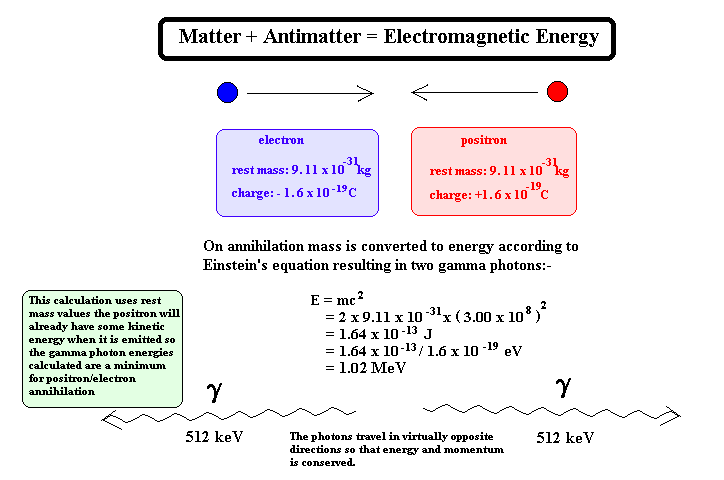    |
||||
 Anti-matter Anti-matter |
||||
|
Not only have we found sub atomic particles but we also now know there is 'anti-matter'. Anti-matter was predicted by Paul Dirac (English physicist - despite the name!) in 1928. He solved the equations for electron orbitals in the atom and proposed negative energy states for electrons. A simple example of how he came to this conclusion is by asking ourselves, 'What is the root of 4?'
A root can produce two possible solutions +2 or -2 ! In 1932 Carl Anderson found experimental evidence for one in a cloud chamber (we study those next year). Anti-matter is the
complement to matter - it has the opposite characteristics. Remember:
An anti-electron is a positron β+.This
anti-particle is positive and has the same mass as an electron. If a positron and electron
meet they annihilate one another - poof! and their combined mass (2me)
is converted to electromagnetic energy (in accordance with the Einstein
equation (E = mc2) - but we don't have to do the maths on that
until A2).  You need to be able to convert from one to the other. Remember at GCSE you learned that: E = Q V (joule) (coulomb) (volt) So, a joule could
be thought of as a 'coulomb volt' Similarly, if we don't use a full coulomb of charge, but only the charge on an electron 'e' eV = e V (electron volt) (charge on an electron) (Volt) The charge on an electron is only 1.6 x 10-19 C Therefore the eV is only 1.6 x 10-19 J Anti-protonThe anti-proton was 'made' in 1955 at the University of California. If a high-energy proton is made to collide with a stationary proton the kinetic energy it possesses can be converted into a matter/anti-matter pair. Just as on annihilation of matter and anti-matter energy is produced, so pure energy can be changed into matter and anti-matter (2mp would be needed). More recently anti-hydrogen was made (an anti-proton and a positron) 'Something material' comes out of 'nothing but pure energy', but it has to appear in such a way that if the process reversed we would wind up with the pure energy again. That is why particles that 'come out of thin air' are always produced in pairs. This is termed pair production. The more massive the particle to be produced the greater the energy required (we will do more on how that energy is supplied in the A2 module but you may find it interesting to look up particle accelerators at this point in the course). Energy for a collision can be provided by an electric field: a 2000V field would accelerate an electron (or a proton - they both have the same charge!) at rest to give it 2keV of kinetic energy; a 6MV field would accelerate an electron at rest to give it 6MeV of kinetic energy; a 9GV field would accelerate an electron at rest to give it 9GeV of kinetic energy etc. If a very high energy proton (enough excess to be converted into a proton and an anti-proton) 'bumps into' (better expressed as 'interacts with') an anti-proton of equal energy, then as well as the two original particles there would be another proton/anti-proton pair!.... the kinetic energy would produce matter instead! Rest mass energy (the energy needed to produce a proton or anti-proton particle at rest!) of a proton is 940MeV. So, to produce a pair we would need 2x940 MeV = 1900 MeV = 1.9 GeV (NB - 2 sig figs here!) If we used a 3GeV accelerator we would have 1.1 GeV left over.... this would be seen as kinetic energy among the particles. Why is there more matter than antimatter in the Universe? (click here to find out!)
|
||||
 |
||||


